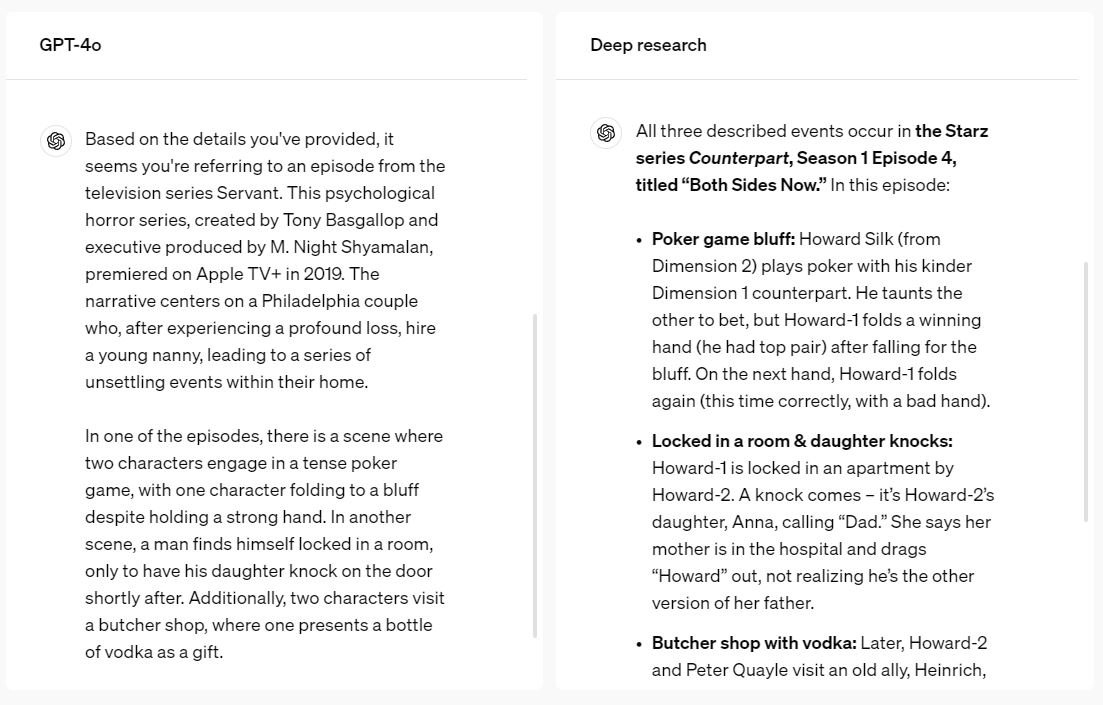I know that ChatGPT can answer any question in a couple of seconds, but that is not something you want all the time. You might want it to go “deeper”, let it take its time, and provide something as detailed as possible. That is what ChatGPT’s new Deep Research mode is designed to do!
I think you would understand it better with examples, so here they are!
ChatGPT Deep Research’s Practical Use Cases
Here’s how OpenAI explained its new feature Deep Research: “An agent that uses reasoning to synthesize large amounts of online information and complete multi-step research tasks for you.“
It means that when you ask ChatGPT to do “deep research”, it will first understand what you want, may ask you some questions regarding it, create related questions on the topic, go to the web, and find the information in a more comprehensive manner (5 to 30 minutes), retrieve and combine all that data and give you a final report.
1) Do Research on Any Topic
Whether you are working in an office or studying, there will be times when you need to research a certain topic. Here, you don’t need one single-page answer (like what ChatGPT will give you instantly); you want to know everything about the topic.
What you used to do is open Google, find multiple articles and research papers on the topic, and read through them. That’s exactly what Deep Research does. Here’s an example of how you can do research for your university class:
OpenAI’s deep research is very good. Unlike Google’s version, which is a summarizer of many sources, OpenAI is more like engaging an opinionated (often almost PhD-level!) researcher who follows lead.
— Ethan Mollick (@emollick) February 3, 2025
Look at how it hunts down a concept in the literature (& works around problems) pic.twitter.com/zAQSBrP2i7
You can see how it went to multiple sources online one-by-one and also explained what it was trying to learn from those sources. After the process, it generated a complete report.
2) Write Your Research Paper
To understand how well it performs, a user asked it to generate a full research paper, what a PhD-level student or a Research Analyst would do. It took 30 minutes for ChatGPT’s Deep Research but it generated a full 18 pages report with citations:
The new OpenAI model announced today is quite wild. It is essentially Google's Deep Research idea with multistep reasoning, web search, *and* the o3 model underneath (as far as I know). It sometimes takes a half hour to answer. Let me show you an example. 1/x pic.twitter.com/tccw7Mecil
— Kevin A. Bryan (@Afinetheorem) February 3, 2025
What makes it different are the following reasons: longer outputs (size of complete reports), analyzing multiple sources on the internet as well as finding only the relevant information by connecting all the dots.
3) Product Research for Shopping
One of the use cases that was shared in the live demo by OpenAI was to do Product Research. One of the engineers asked it to find the best ski ⛷️ for him. First, ChatGPT asked him for some additional information to refine the research process.
After a few minutes, a complete research report was generated, along with a table at the end comparing multiple skis on the market. So, if you want to buy something but don’t know much about the category, then try it.
Where it helps you is it will not just spit out the top 5 products on the market, but it also tells you what you need to know about the product and its features. This way, you also learn more about the products and understand the criteria on which ChatGPT gave its final recommendations.
4) Market Research
Any company does research before launching a new product or service. It may take days, weeks, or even months to complete it. There will be multiple research papers, statistics reports, and blogs on the internet to go through. Let ChatGPT do it as shown in this official demo:
🚨 Breaking: ChatGPT just dropped DeepResearch, an AI agent tool that searches, analyzes, and synthesizes data faster than any human. 🤯
— Javaid Shah (@JvShah124) February 3, 2025
Tasks that would take hours to complete can now be completed in minutes.
Here's everything you need to know 👇 pic.twitter.com/CXVEAHCb0j
In this example, the user wanted a report on changes in the retail industry in the last 3 years. Maybe you are an entrepreneur who wants to create a SaaS for the retail industry. The research report will give you enough material to understand the status of what’s happening in the world.
5) Find Something That You Forget
What if you want to find the name of an old TV show but you remember a popular scene from it, a restaurant you visited years ago, or a song that you know what it is about, but forget the lyrics completely? You will go to Google or ChatGPT but if the information is not directly available on some website, it would be difficult for them to find it.
That’s where the multi-step research capabilities of Deep Research will come into play. See the example:

GPT-4o was able to retrieve information from its database or browse the web quickly resulting in a simple answer that might be incorrect. On the other hand, Deep Research did its “creative” thinking and presented with a detailed answer.
Conclusion
As more and more people try this feature, we will find out whether it is worth it or not. OpenAI says this mode is great for researchers in finance, science, policy, and engineering. There are many other players in the market for the same use cases, but with the branding of OpenAI, this will outshine them right now.








